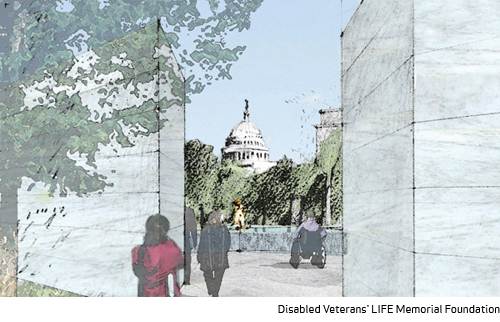Dignitaries break ground for new memorial to disabled veterans
Construction to begin near the Capitol for tribute to 3 million veterans living with disabilities.

Two Veterans Affairs secretaries and the Speaker of the House were among the dignitaries who joined a crowd of some 400 on Wednesday at a groundbreaking ceremony for Washington's newest monument, the American Veterans Disabled for Life Memorial.
On a strip of land hear the U.S. Botanical Garden with a sight line to the Capitol, the privately funded memorial will take the form of a star-shaped pool, ceremonial flame, panel of glass walls and four bronze sculptures. It is scheduled for completion by Veterans Day 2012.
Veterans Affairs Secretary Eric K. Shinseki, in thanking the donors and the leaders of the Disabled American Veterans who first conceived the project 12 years ago, said, "The price of liberty has been paid by the vigilance and valor of the many young Americans" who put service to country above self and "displayed a courage at which we can only marvel." One of his predecessors, Anthony Principi, said, "Lifelong disabilities are part of veterans' contribution to the cost of war," and quoted the aphorism from Gen. John J. Pershing that "time will not dim the glory of their deeds."
House Speaker Nancy Pelosi, D-Calif., reviewed the bipartisan efforts in Congress to enact the New GI Bill and expanded veterans health care. She called the new memorial "a very specific step in recognizing those who are disabled but who continue to contribute to the strength of America." Vowing to "leave no veteran behind," Pelosi also warned against proposals to privatize the Veterans Affairs Department's health care system.
Actor Gary Sinise, chosen as the memorial's national spokesman because of his activism on behalf of veterans since his breakthrough role as a troubled Vietnam veteran in the 1994 film Forrest Gump, told the crowd, which included numerous veterans, of how his character of Lt. Dan endured the pain and anger his mental and physical injuries caused "and eventually learns to accept and live with his injuries, stand tall and proud, put his injuries in perspective and move on."
The first-of-its kind memorial to the estimated 3 million American veterans now living with war-related disabilities received no federal funding, though its planners have cooperated with Veterans Affairs and the Defense Department. Efforts by a foundation started by philanthropist Lois Pope have raised some $82.5 million toward the $86 million projected costs, mostly from 1,058,000 individual donors. Because the site is federal property, planners were required to go through a 24-step approval process under the U.S. Commemorative Works Act, with signoffs from the U.S. Commission on Fine Arts, National Capital Planning Commission and National Park Service.



